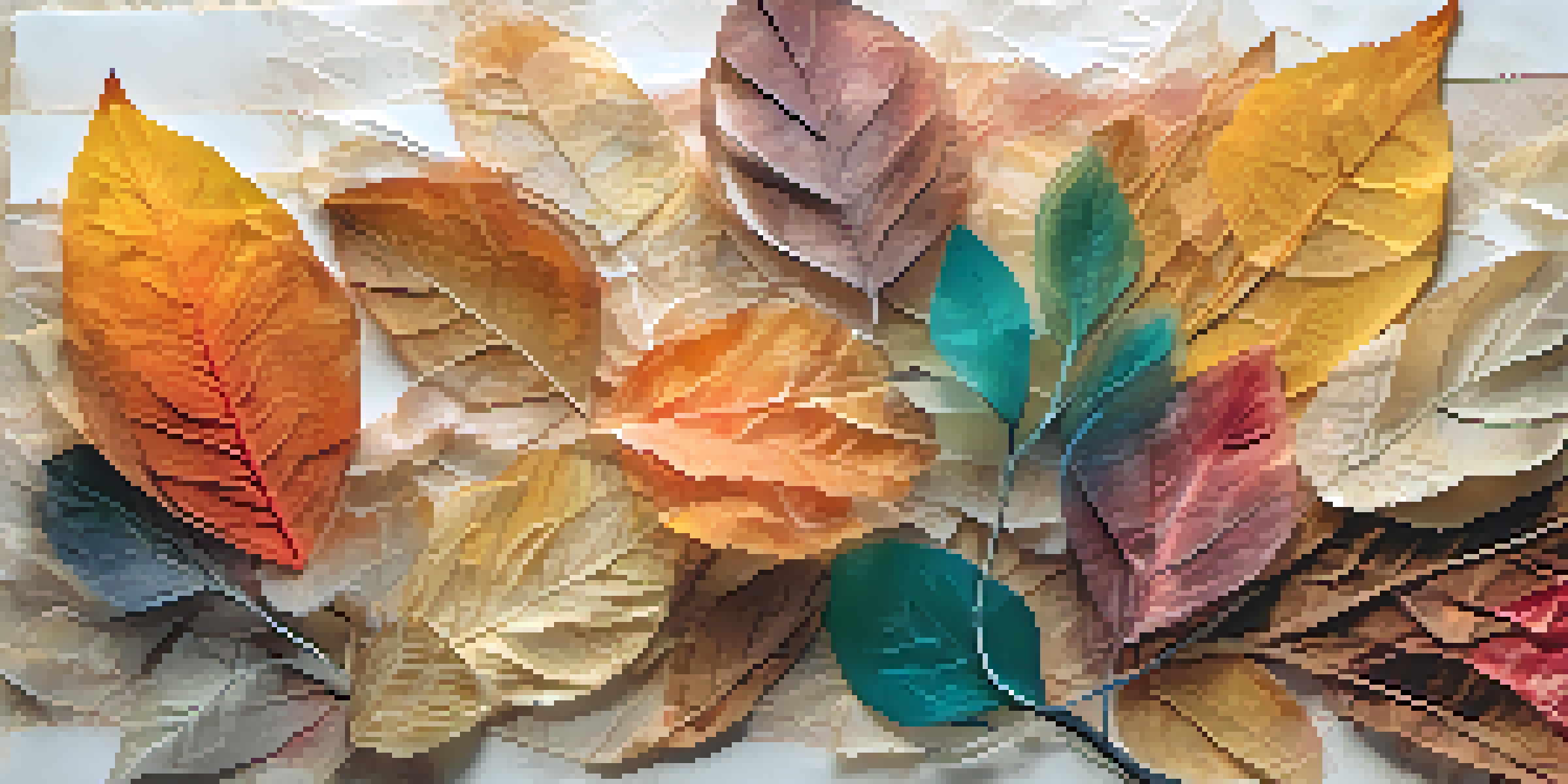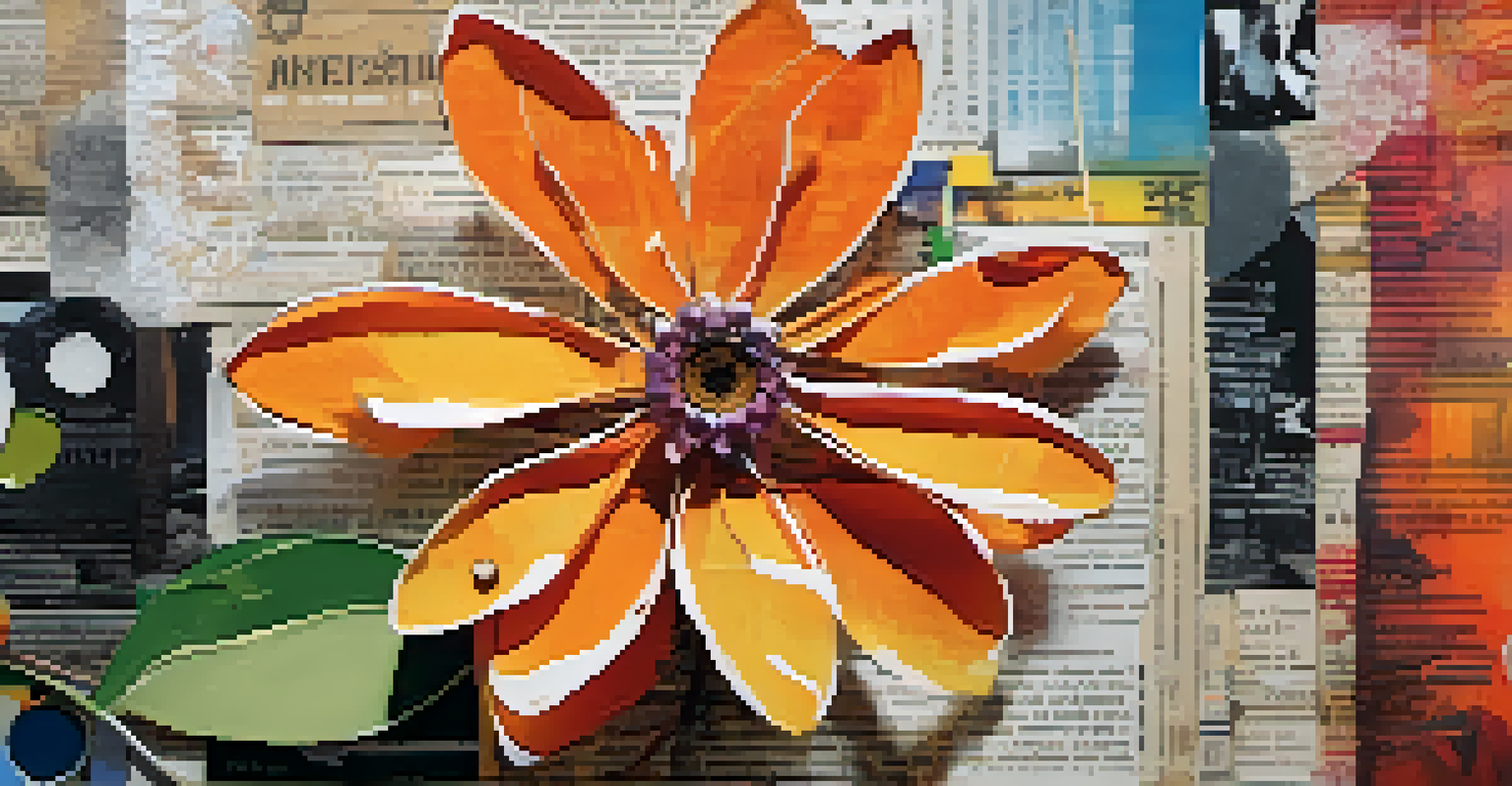Creating Depth with Layering Techniques in Mixed Media Art

Understanding Layering in Mixed Media Art
Layering is a fundamental technique in mixed media art that adds depth and complexity to your work. By combining different materials and mediums, you create a rich visual experience that invites viewers to explore. Think of layering as building a sandwich: each ingredient adds unique flavor, just like each layer enhances the overall composition of your art.
Art is not what you see, but what you make others see.
The beauty of layering lies in its versatility. You can use paint, paper, fabric, or even found objects to create layers, allowing for endless creative possibilities. This technique not only enhances the aesthetic appeal but also conveys emotions and narratives through the interplay of textures and colors.
To get started, gather a variety of materials and consider how they might interact. Experimentation is key—don’t be afraid to mix and match different elements to discover what resonates with you. As you layer, you'll find that each addition transforms the piece, much like adding spices to a dish can elevate its flavor.
Choosing Your Base: The Canvas Matters
The foundation of your mixed media piece can greatly influence the layering process. Selecting the right canvas, whether it’s traditional canvas, wood panels, or even paper, sets the stage for your artwork. Each surface has its own characteristics, which can affect how materials adhere and interact.

For instance, a textured canvas can add an exciting dimension to your layers, while a smooth surface may require careful application to prevent streaks. Consider the final effect you want to achieve and choose a base that complements your vision. As you plan, remember that the base is just the beginning of your layering journey.
Layering Adds Depth to Art
Layering different materials and mediums creates a rich visual experience that enhances the complexity and emotional depth of mixed media art.
Don’t hesitate to experiment with unconventional surfaces, such as cardboard or glass, to add unique textures and effects. Each choice opens up new avenues for exploration, allowing your creativity to flourish. Ultimately, your base sets the tone for your layered masterpiece.
Exploring Different Materials for Layering
In mixed media art, the variety of materials available is both exciting and overwhelming. From acrylic paints to collage elements, each medium brings something special to the table. The key is to understand how these materials interact when layered, as some may blend seamlessly while others create striking contrasts.
Every artist dips his brush in his own soul, and paints his own nature into his pictures.
Consider incorporating both opaque and transparent materials. For example, layering a translucent wash of paint over a solid color can create depth and intrigue, much like the effect of sunlight filtering through leaves. This interplay of materials not only adds visual interest but can also evoke different emotions and moods.
Don’t shy away from using unconventional items like fabric scraps, newspaper clippings, or even natural elements like leaves. These can add richness to your layers and tell a story that resonates with viewers. By mixing materials, you not only enhance the depth of your piece but also celebrate the beauty of diversity in art.
Techniques for Effective Layering
To achieve depth in your mixed media art, employing specific techniques can make a significant difference. One popular method is glazing, where you apply a thin, transparent layer over dried paint to alter its color and tone without hiding the underlayer. This technique allows for subtle shifts in visibility and can create a stunning visual effect.
Another effective technique is collage, where you arrange and adhere various materials to the canvas. By overlapping pieces, you can create a dynamic sense of movement and depth. Play with scale and orientation to guide the viewer’s eye through the artwork, drawing them into the layers you've created.
Choose the Right Canvas
The type of canvas you select significantly impacts the layering process and overall aesthetic of your artwork.
Lastly, consider using texture mediums, such as modeling paste or gels, to build physical layers on your canvas. These can add a three-dimensional quality that invites touch and interaction, enhancing the overall experience of viewing your art. Remember, the goal is to create layers that not only look good but also engage the viewer on multiple levels.
Color Theory: Layering for Visual Impact
Understanding color theory is essential when layering in mixed media art. Colors can evoke emotions and set the mood for your artwork, so thoughtful layering of hues can enhance the overall impact. For instance, warm colors tend to advance, while cool colors recede, creating a sense of depth and space.
When layering colors, consider using complementary shades to create contrast or analogous colors for harmony. A well-planned color palette can guide the viewer's eye from layer to layer, creating a cohesive experience. Think of your artwork as a visual symphony, where each color plays its part in the overall composition.
Don’t forget to experiment with opacity and transparency. Layering transparent colors over one another can produce unexpected and vibrant results, akin to mixing colored light. This playful exploration can lead to beautiful discoveries that enhance the depth of your mixed media project.
Creating Focal Points with Layering
Incorporating focal points is crucial when layering in mixed media art. A focal point draws the viewer's attention and can be achieved by manipulating layers strategically. For instance, you might use brighter colors or bolder textures in one area to create emphasis, contrasting it with softer, more subdued layers surrounding it.
Another effective way to establish a focal point is through the use of scale. A larger element can dominate a smaller background, guiding the viewer’s gaze right where you want it. Think of it like a spotlight on a stage: the focal point becomes the star of the show, with layers supporting its prominence.
Sealing Preserves Your Artwork
Using a proper sealant protects your layers and ensures the longevity of your mixed media masterpiece.
Moreover, consider the placement of your focal point within the composition. Using the rule of thirds can help create a more dynamic arrangement, allowing layers to frame and highlight your main subject. This intentional design can add depth while keeping the viewer engaged with your artwork.
Final Touches: Sealing and Protecting Layers
Once you’ve achieved your desired layering effect, it’s time to think about sealing and protecting your artwork. A good sealant can help preserve the integrity of your layers, preventing them from fading or smudging over time. It’s like putting a protective umbrella over your creation, ensuring it stands the test of time.
There are various sealants available, such as sprays, varnishes, or gels. Each offers different finishes—matte, glossy, or satin—allowing you to choose one that complements your artistic vision. Don’t forget to test your sealant on a small area first to ensure it doesn’t alter the appearance of your layers.

Additionally, consider how the finished piece will be displayed. Framing or mounting can further protect your art while enhancing its presentation. Taking these final steps ensures that your layered masterpiece not only looks stunning but also endures for years to come.